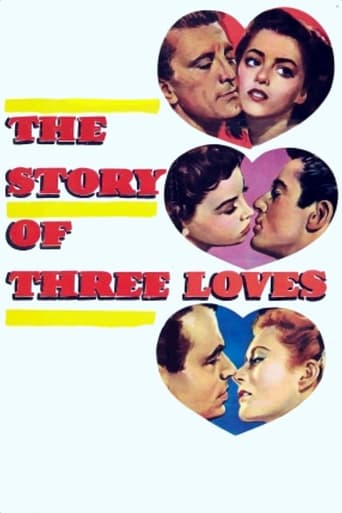jjnxn-1
Interesting mix of short stories with a galaxy of stars both major and minor. The first with James Mason and Moira Shearer has beautiful music and dancing but a rather overwrought storyline and wastes Agnes Moorehead in a nothing role. The last with Kirk Douglas and Pier Angeli is suffused with sorrow made especially poignant since she plays a girl saved by Kirk from suicide, such was not the case in real life and she ended up taking her own life several years later. The real charmer is the middle episode, a precursor to the film Big, with Ethel Barrymore as an elderly enchantress, Leslie Caron and Farley Granger sweet in a story of young love. Most enjoyable.
moonspinner55
Trio of stories--a popular movie gimmick in the 1950s--linked by an ocean-liner and three disparate characters on-board. James Mason is intense and snarling as a demanding ballet impresario who falls for ill-fated ballerina Moira Shearer, who, unbeknownst to him, is suffering from a bad ticker; Leslie Caron plays governess to ungrateful brat Ricky Nelson, both magically touched by the powers of Ethel Barrymore, reputed to be a witch; Kirk Douglas (as Pierre!) is a former star of the trapeze who trains suicidal Pier Angeli to be his new partner under the Big Top. The first two episodes are hurt by a weak narrative (the protagonists appear to recall information they should not be privy to), while the last chapter is hurt by miscasting (neither Douglas nor Angeli looks quite comfortable doing these gymnastic moves). However, the M-G-M production gloss is in peak form, and the picture looks good enough to eat. After a lengthy credits sequence (illustrated with the silhouette of a tree branch!), the color visuals take over, as if in a dream, and the effect is hypnotic. Not so the dialogue, which is heavy on the melodramatic flourish (Agnes Moorehead to the doctor: "Paula must dance or she will die!", to which the doctor replies gravely, "If she does...she will!"). Douglas is so mercurial in his angst that he's amusing unintentionally, while sullen Angeli is made up to look like a corpse in a silent movie. Still, one is drawn into this sumptuous bag of tricks almost against his will, and the overall results are fun for '50s connoisseurs. *** from ****
sandibiaso
I loved this movie especially the the third segment featuring Pier Angeli. She really did her best portraying a suicidal widow of a Holocaust victim who becomes a trapeze artist after she is saved from drowning by Kirk Douglas's character. I am pretty sure that she relied on her own childhood in Rome for inspiration. She grew up in Rome when World War II was occurring. Her emotional scenes were the best. I can see why Kirk Douglas fell in love with her. It is hard to believe she was only nineteen when she filmed the movie. It is the first color film she did. I think it was be remembered by devoted Anna Maria Pierangeli fans for years to come.
ellenburr
This is one of the few movies that I've watched repeatedly or when I need an attitude boost. (Others are Harold & Maude and What a Wonderful Life.) I walk away with renewed sense of empowerment, purpose and determination. In addition to that, I enjoyed: 1) the timing--the movie consists of three shorts and I appreciate the order in which the three are presented; 2) sense of humor--the second short is quite charming and I thought well written from a child's point of view--it avoids being an adult pretending to be a child; 3) long dance scenes--there must be several three minute scenes with no editing cuts (the music is so strong that whenever I hear a piece by Faure, if it's not the piece in this one scene it reminds me of it, that I must stop a few seconds because the memory is so alive); 4) the deep exploration of "what is right" --I not only appreciate the presentation of the two sides of every decision presented in all of the shorts, but also that a quick Hollywood solution is resisted; and finally 5) a young Kirk Douglas--which is the old fashioned manly-man. My only wish is that is would be shown on the big screen more often.




